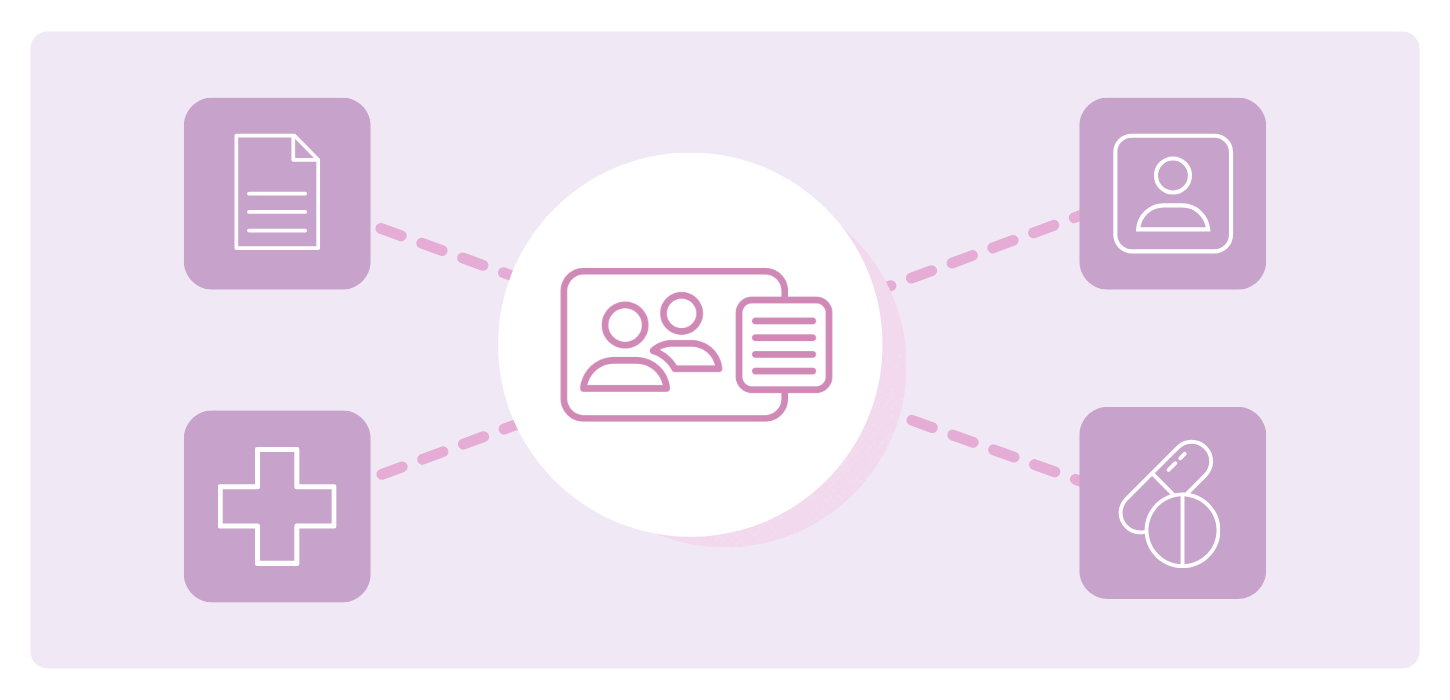At A Glance
Identity resolution unifies fragmented IDs into complete customer profiles, helping companies understand their audiences and deliver personalized, privacy-compliant experiences in a cookie-light world. With Experian’s AI-powered identity resolution solution, marketers gain the scale, accuracy, and compliance to compete while making marketing more human.In this article…
Every marketer has seen it: a customer browses reviews on a laptop, adds items to a cart on mobile, then “disappears.” In reality, they just likely switched devices or logged in with a different email. Identity resolution connects these scattered signals into a single profile so you never lose sight of the customer journey.
Identity resolution is what helps you keep track of customers who bounce around.
Connecting scattered signals into a single customer profile can help you deliver seamless experiences, meet strengthening privacy standards, turn first-party data into measurable results, and fuel better customer analytics.
See our identity resolution solution in action
What is identity resolution?
Identity resolution is the process of pulling together the different identifiers a customer uses and connecting them to a single profile. Without it, you’re left with an incomplete picture of the customer — like a cart tied to one email, an app login tied to another device, or a loyalty swipe that never links back to the same person.

Common identifiers include:
- Cookies: Short-lived browser data
- Emails: Plain-text and hashed
- Device IDs: Mobile advertising IDs (MAIDs) or app-based identifiers
- Loyalty IDs: Program numbers that tie online and offline activity
- Hashed PII: Personally identifiable information (PII) encrypted for privacy
Ultimately, identity resolution can help you recognize the same customer wherever they engage.
Why does identity resolution matter now?
Marketers face incomplete views, data silos, privacy regulations, and shrinking visibility:
- Rising consumer expectations: People want seamless, personalized journeys across touchpoints.
- Privacy-first environment: Consumer privacy legislation (like the GDPR, CCPA, GLBA, FCRA, and new state laws) makes compliance non-negotiable.
- Signal loss: The decline of cookies, MAIDs, and walled gardens are pushing brands toward first-party data.
Experian utilizes AI and machine learning to fill these gaps, predict behaviors, and connect signals across devices — providing marketers with a clear, privacy-safe view of their customers, even when traditional identifiers are missing.
In this environment, identity resolution matters because it gives marketers a way to deliver seamless, personalized customer experiences and engage audiences effectively while respecting their privacy. It’s the basis for turning consented first-party data into measurable marketing outcomes without sacrificing trust.
Why is identity resolution critical in a privacy-first world?
Even as cookies linger, marketers have already shifted their strategies to rely on first-party data, where choice and transparency are the baseline expectation. At Experian, our long history as a regulated data steward makes us a uniquely capable and trusted partner for managing modern compliance expectations. Our identity resolution solutions maximize the value of permission-based data while meeting consumer demand for privacy, personalization, and control.
Struggling with scattered customer data? Experian makes identity resolution seamless
How does identity resolution help brands?
Identity resolution turns fragmented signals into unified profiles that drive personalization, efficiency, and compliance. Here’s how it creates measurable business impact.
Creates a unified customer view
One of the biggest advantages of identity resolution is the ability to integrate data from loyalty programs, point-of-sale (POS) systems, customer relationship management (CRM) platforms, web analytics, and offline sources into a single, comprehensive profile. Experian strengthens identity resolution with AI-driven clustering models that resolve household and individual identities across billions of signals with greater accuracy.

With a clearer picture of each customer, brands see higher match rates and larger addressable audiences, which translates to more substantial reach and better return on ad spend (ROAS).
Enables better personalization
Customers constantly switch devices, update their information, and change preferences. Experian makes it easier to keep pace with these changes through frequent data enrichment and near-real-time identity resolution via Activity Feed.
Combined with our long-standing use of AI and machine learning, this approach ensures shifting behaviors are captured quickly, enabling timely personalization, and more responsive engagement.

With less delay from data to action, the result is faster response times and higher conversion rates.
Improves the customer experience
Customers notice when brands deliver relevant ads and contextual content across every channel. Consistency matters! But consistency doesn’t just happen on its own; it comes from identity resolution, which keeps the customer journey connected.

As brands maintain continuity, they build trust, strengthen engagement, and increase customer lifetime value.
Drives better marketing ROI
Not every profile is valuable. Identity resolution helps marketers identify the highest-value audiences and reduce wasted spend.

That efficiency leads to lower CPA and a higher overall ROI across campaigns.
The power of modeling from a stronger foundation
When you have a unified customer view, your models are built on better data. That means you can find more people who look like your best customers, build more responsive audience segments, and target with greater accuracy. This foundation can lead to better spending, more relevant campaigns, and a higher ROI.
Maintains privacy compliance
With GLBA/FCRA-grade standards and consumer choice mechanisms like opt-outs and data correction, you can protect your brand while maintaining personalization — without compromising legal or ethical safeguards.

What are some identity resolution use cases and examples?
Every industry faces its own unique identity challenges, but identity resolution is the common thread that turns scattered data into connected experiences. Let’s break down how companies in different verticals are putting it to work (and the kinds of results they’re seeing).
Retail and e-commerce
Shoppers bounce between websites, carts, and checkout lines, leaving behind scattered signals in the process. In retail, identity resolution bridges the gap between online and in-store experiences by matching online carts with loyalty swipes or connecting connected TV (CTV) exposure to in-store sales. This means fewer silos, better targeting, and more personalized offers wherever people shop.

Our 2025 Digital trends and predictions report calls out that omnichannel experiences aren’t optional anymore. With CTV and social dominating spend, brands need identity resolution to cut through silos and build a complete view of customer behavior.
Financial services
In financial services, identity resolution makes it possible to deliver personalized, compliant offers like refinancing options for likely mortgage switchers or the right rewards card for frequent spenders.
Our partnership with FMCG Direct to create Consumer Financial Insights® and Financial Personalities® segments helps banks, insurers, and lenders understand behaviors — such as credit card use, deposit balances, and investment habits — without exposing sensitive details.
Read more below about how our financial audiences enable privacy-safe personalization.
Travel and hospitality
Travel decisions aren’t always planned out in advance. Many bookings happen spur-of-the-moment, which is why real-time identity resolution is so powerful; it keeps the journey seamless when travelers jump from phone to laptop to tablet and presents relevant offers right as decisions are being made.
Windstar Cruises put this information into action with Experian’s identity graph to connect digital interactions with actual bookings, which drove 6,500+ reservations and $20 million in revenue.
Media and TV
Viewers tend to hop around between linear TV, streaming apps, and social feeds. And without identity resolution, every screen looks like a different person. Marketers can accurately plan, activate, and measure campaigns by unifying viewing behaviors into one ID with Experian’s AI-powered identity graph.

Optimum Media tackled its multiscreen challenge by partnering with Experian for identity solutions. Layering our audience insights and our AI-driven Digital Graph onto their subscriber data, they were able to connect the dots across channels, reach the right households, and measure results instead of just impressions. In the end, they finally got a clear view of what works across every screen.
Curious how identity resolution can power your customer analytics? We can walk you through it.
Healthcare and pharma
Healthcare marketers can’t afford slip-ups with HIPAA regulations. Identity resolution makes it possible to engage the right patients and providers with de-identified audiences rather than third-party cookies.

At Experian, AI and machine learning have always been part of how we power identity resolution. In healthcare, that means using AI-enhanced modeling to connect de-identified clinical and claims data with lifestyle insights. The result is a more comprehensive picture of the patient journey that helps close care gaps, reduce wasted spending, and improve outcomes.
By working with partners like Komodo, PurpleLab, and Health Union, we make it possible to activate campaigns at scale that boost engagement and adherence while keeping patient privacy front and center:
- Komodo Health enriches our identity graph with insights from millions of de-identified patient journeys plus lifestyle data, giving brands a fuller view of where care gaps exist and how to close them.
- PurpleLab connects real-world clinical and claims data to Experian’s platform, letting advertisers activate HIPAA-compliant audiences across CTV, mobile, and social with the ability to measure real outcomes like prescription lift and provider engagement.
- Health Union contributes a data set built from 50 million+ patient IDs and 44 billion+ patient-reported data points. Combined with our identity and modeling capabilities, this expands match rates and unlocks up to 76% net-new reach, so campaigns reach patients and caregivers in critical health moments.
As a result, healthcare brands can launch campaigns that are privacy-first, highly targeted, and proven to drive meaningful impact.
Audio
People use audio while commuting, working out, and even folding laundry. It can be one of the hardest channels to track because of how frequently listeners switch between apps, stations, and devices.

Experian’s identity resolution partnerships with Audacy and DAX change the game:
- Audacy helps tie scattered listening into a single view, so advertisers can follow audiences across devices and keep ads relevant in the moment.
- DAX pairs Experian’s 2,400+ syndicated audiences with its audio network, enabling brands to target precisely and launch impactful campaigns at scale.
These partnerships turn audio into an accurate channel where ads feel personal, privacy-safe, and measurable.
Gaming
Gamers don’t stick to one platform. Player data gets scattered across mobile, console, and PC, so it’s tough to keep track of individuals. Experian helps stitch those signals together so publishers can finally see the whole picture, personalize gameplay, and keep players coming back.
With enriched profiles, publishers can deliver offers that resonate and unlock fresh revenue by packaging high-value gaming audiences for advertisers outside the industry.
Unity, a leading gaming platform, is tapping into Experian’s syndicated audiences to gain player insights and help advertisers reach gamers across mobile, web, and CTV. For global publishers, unifying player data with Experian has driven higher engagement and stronger ad ROI.
How should I evaluate identity resolution providers?
When choosing an identity resolution partner, look for:
- Data scale and quality: The value of identity resolution depends on how complete and accurate the underlying data is. The right provider should bring together a wide range of identifiers from online and offline sources, maintaining high accuracy so your customer profiles are broad and reliable.
- Match accuracy and recency: The best partners also refresh their data regularly and can blend deterministic (exact, one-to-one matches) with probabilistic (pattern-based matches) methods. That way, you get the accuracy of “this email is definitely that customer” with the reach of “this device likely belongs to the same person.”
- Privacy and compliance readiness: Compliance can’t be an afterthought. Your identity partner should be ready for GLBA, FCRA, GDPR, CCPA, and the latest state-level rules with built-in tools for opt-outs, corrections, and deletions.
- Integration flexibility: A good provider fits into your world, not the other way around. Look for pre-built integrations with your customer data platform (CDP), demand-side platform (DSP), or marketing tech (MarTech) stack so you can get up and running without the heavy IT lift.
- Data analytics capabilities: You need proof that identity resolution drives ROI. Look for closed-loop measurement that ties unified IDs directly to campaign performance, so you can see what’s working and optimize with confidence.
How Experian enables enterprise-grade identity resolution
Experian delivers identity resolution at the scale, accuracy, and compliance required by the world’s largest enterprises. Our solutions are:
- Built on trust: Backed by 40+ years as a regulated data steward and rated #1 in data accuracy by Truthset, so you can act with confidence.
- Powered by our proprietary AI-enhanced identity graph: Combining breadth, accuracy, and recency across four billion identifiers, continuously refined by machine learning for maximum accuracy.
- Seamlessly connected: Pre-built data integration with leading CDPs, DSPs, and MarTech platforms for faster time to value.
- Always up to date: Frequent enrichment and near-real-time identity resolution through Activity Feed for timely personalization and more responsive customer engagement.
- Privacy-first by design: Compliance with GLBA, FCRA, and emerging state regulations baked in at every step, supported by rigorous partner vetting.
The bottom line
Identity resolution turns fragmented signals into connected, measurable, and compliant experiences. From retail to gaming, brands using it see stronger personalization, engagement, and ROI.
With Experian, you get the data, trust, and responsible AI innovation to make identity resolution work across every channel. Our approach uses AI to connect identities, predict behaviors, and deliver personalization that balances privacy with performance. If you’re ready to turn fragmented data into growth, now’s the time to start.
The world’s leading brands trust us to power identity resolution at scale. See how we can do the same for you.
Identity resolution FAQs
Deterministic uses exact identifiers (like an email) for accuracy, while probabilistic uses signals and algorithms to expand reach. Best-in-class providers usually combine both.
Identity resolution helps with personalization by unifying scattered signals into one profile. It reduces wasted spend and increases match rates, which means bigger addressable audiences and higher ROAS.
Yes. With first-party data and hashed PII, brands can still maintain addressability and personalization.
Retail, finance, travel, media, gaming, and audio all use identity resolution to personalize, attribute sales, and improve efficiency.
A customer data platform unifies the data you already own. Meanwhile, we add depth, scale, and higher match rates by layering in our identity graph and data enrichment.
Yes. Experian is GLBA/FCRA compliant, GDPR/CCPA ready, and supports consumer opt-outs and corrections to ensure responsible personalization.
Latest posts

In this article…Why AI and CTV are a great matchThe rising popularity of CTVHow is AI already being used in CTV?Demand-side platforms Artificial intelligence (AI) and connected TV (CTV) have a perfect synergy that’s revolutionizing how advertisers connect with their audiences. CTV serves as a medium for streaming content, while AI acts as a sophisticated technology that improves the performance of CTV advertising campaigns. The integration of these two technologies has paved the way for advertisers to reach their target audience more effectively, making CTV advertising a powerful and efficient tool. In this blog post, we’ll dive into how these technologies work together — and why you should jump on board with AI for CTV advertising if you haven’t already. Why AI and CTV are a great match CTV and AI are transforming how advertisers connect with their audiences and improving the performance of their advertising campaigns in the CTV space. They work together to make advertising smarter and more enjoyable for everyone involved. AI uses sophisticated computer programs to analyze and understand data, while CTV refers to the streaming services that consumers use at home. But what makes them a great match in advertising? AI uses data to determine which TV ads are most exciting and relevant to certain people, and it can even adjust ads in real time to ensure viewers are always getting the most personalized experience. AI can provide suggestions to viewers based on previously watched content to help them find what they’d enjoy watching next. To sum it up, AI allows for: Precise targeting: AI uses data to determine which TV ads are most exciting and relevant to certain people. Personalization: AI can adjust ads in real time to ensure viewers are always getting the most personalized experience. Effective ad insertion: AI can provide suggestions to viewers based on previously watched content to help them find what they’d enjoy watching next. CTV facilitates these AI-driven strategies for enhanced user engagement and satisfaction. The rising popularity of CTV CTV has become increasingly popular as people change the way they watch TV. Instead of the traditional approach, more viewers are now choosing CTV platforms for their entertainment. One of the main reasons for this shift is that CTV offers greater flexibility and lets viewers watch content at their convenience. The ability to skip ads on many CTV platforms also improves the experience. CTV offers a great opportunity to interact with your target audience in a more engaging way. CTV allows for highly targeted advertising capabilities so you can reach specific demographics and households with tailored messages. Additionally, CTV provides valuable data insights that enable you to measure campaign effectiveness accurately. If you haven’t embraced this advertising channel yet, you may be missing out on a growing and engaged audience. Here are three reasons you should add CTV to your advertising strategy. Global video ad impressions As a global platform, CTV has the unique ability to reach audiences worldwide. Unlike traditional TV, CTV transcends geographical boundaries and brings marketers a global audience, which makes it an ideal channel for global ad campaigns. No matter your target audience, they’re consuming content on CTV. In fact, a recent study showed that 51% of global video ad impressions came from CTV in 2022. This abundance of global video ad impressions generates vast amounts of data, which AI can process in real time to help you make data-driven decisions and optimize your campaigns for diverse international audiences. AI can analyze viewer data from various regions, identify audience preferences and behaviors across borders, and tailor ad content accordingly. These data analysis capabilities ensure your ads get in front of the right viewers. Viewers prefer ad-supported CTV In 2020, the viewing time of ad-supported CTV surged by 55% while subscription video on demand decreased by 30%, according to TVision Insights. Viewers have a well-established preference for ad-supported CTV due, in part, to cost-effective access to premium content. Viewers are more engaged and less resistant to ads, as AI tailors ad content to viewer preferences and behavior to enhance ad relevance. AI-powered insights can also aid in viewer retention and help you optimize your CTV campaigns. By accommodating viewers’ preference for ad-supported CTV and harnessing AI to improve the ad experience, you’re more likely to be successful in your marketing efforts. CTV outpaces mobile and desktop for digital video viewing eMarketer recently reported that U.S. adults spend 7.5+ hours each day on CTV — more than half of their digital video viewing time. Comparatively, they only spend 37.5% of their viewing time on mobile and 10% on desktops and laptops. These statistics demonstrate that CTV has become the preferred platform for digital video consumption, as viewers enjoy larger screens with superior quality for an immersive experience. It's important to note that AI is an essential CTV marketing tool, as it allows for precise targeting and content optimization. By utilizing AI on CTV, you can take advantage of this trend and deliver more engaging and effective campaigns to a growing and engaged audience. How is AI already being used in CTV? CTV has been integrated with AI across various facets and has revolutionized the television landscape. Here's a look at how AI is already shaping the CTV experience: Generative AI ads Generative AI ads are taking CTV personalization to a whole new level. These innovative ads are customized versions of the same CTV ad to suit individual viewers. Some AI tools can generate several versions of the same CTV ad — swapping the actor’s clothing and voiceover elements like store locations, local deals, promo codes, and more — and can create up to thousands of personalized iterations in just a few seconds. Such capabilities are a game-changing approach to connecting with your audience. Next, we dive into the advantages and impact of generative AI ads, and explore their transformative role in CTV advertising. Contextual ads vs personal data Generative AI ads use personal data, such as viewing history and demographics, to create highly personalized ad experiences. This sets them apart from contextual ads, which rely solely on the content being viewed. Using AI to harness this data, you can move beyond traditional contextual targeting and ensure your ads connect with viewers on a more individualized level. Generative AI ads can be used to A/B test Generative AI ads are not just about personalization; they also open the door to A/B testing. Being able to create several versions of one ad quickly allows you to experiment with various ad elements, such as messaging, visuals, and calls to action, to identify what works best for different segments of your audience and drives the best performance. This flexibility is especially valuable for refining ad campaigns and maximizing their impact. What’s next for AI-generated ads like this? The potential of AI-generated ads is exciting. As AI technologies constantly advance, we can expect even more personalized and automated CTV advertising. It’s a good idea to keep up with the latest AI-driven innovations to create more effective ad campaigns in the fast-evolving CTV space. The possibilities are endless, and you’ll likely find the most success when you embrace AI in CTV advertising. Optimize streaming quality AI helps viewers enjoy more seamless CTV experiences. By assessing network speed and user preferences, AI optimizes video quality in real time to reduce buffering interruptions. For instance, streaming platforms use AI to adjust video settings based on a user's connection speed. This guarantees an uninterrupted and enjoyable viewing experience. Review content for compliance AI also has a part to play in quality assurance and compliance management. It assesses content alignment with technical parameters and moderates compliance with local age restrictions and privacy regulations. This means AI can identify and filter out unsuitable content to provide a safer and more enjoyable viewing environment for audiences while safeguarding brands from association with undesirable material. Voice command AI-powered voice command technology is increasingly used to control CTV viewing. This technology is embedded in streaming devices and smart TVs and allows viewers to interact with their CTV content through voice-activated commands. This personalizes the viewing experience and improves convenience, as it eliminates the need for remote controls. CTV-integrated voice assistants like Google Assistant, Amazon Alexa, Apple Siri, and Samsung Bixby offer a more human-like interaction with the television, allowing users to give commands and receive tailored responses. Content recommendations AI can offer content recommendations that provide viewers a more personalized and engaging experience. Major over-the-top (OTT) services like Netflix, Hulu, and Amazon Prime use AI-driven data analysis to deliver tailored content suggestions to their audiences. By analyzing user habits in detail, AI can recommend content based on factors such as actors, genres, reviews, and countries of origin. This personalized approach helps viewers discover content that matches their preferences and enhances their viewing experience. Advertising Programmatic ad buying, driven by AI, automatically matches ad placements to specific audience segments based on behavioral patterns. It improves ad delivery by moving away from gross rating points (GRP) to more intelligent and targeted placements. This benefits marketers by ensuring ads are seen by the right people at the right time. It’s also cost-effective for publishers, as it maximizes the sale of ad spots to suitable buyers. Automatic content recognition (ACR) technology, which AI powers, is integrated into smart TVs and streaming devices to improve ad relevance. It provides contextual targeting and extends the reach of ads across multiple devices. For example, platforms like Roku use ACR data to display ads to viewers who haven’t seen them on traditional TV. Similarly, Samba TV retargets mobile users based on IP address and aligns their viewing habits with their smart TVs. Demand-side platforms CTV advertising relies heavily on demand-side platforms (DSPs) to efficiently manage and optimize ad campaigns. These platforms use machine learning and AI in several important ways: Using machine learning and AI to address data fragmentation Data is abundant but fragmented when it comes to CTV advertising. DSPs are flooded with a massive amount of data, including information about households, viewer behavior, and viewing patterns. This data is far too much for manual analysis to handle effectively, which is where AI comes in. By integrating machine learning algorithms into DSPs, AI can harmonize this fragmented data and provide valuable insights and a holistic view of your audience. AI can process zettabytes of data in real time, which streamlines the decision-making process and empowers you to compete quickly for limited CTV impression opportunities. Predicting advertising outcomes with AI AI is quickly changing the way we predict and optimize advertising outcomes. TV buying and optimization platforms are now using AI to improve ad performance. With machine learning, these platforms can anticipate which ad creatives will produce the best results based on various non-creative factors. These include the context of the ad, the audience's profiles, the time of day it is displayed, and the frequency of the ad display. By relying on AI to make these predictions, you can make sure your campaigns are highly optimized for success and deliver more relevant, compelling ads to viewers. Optimizing generative ads AI is also driving optimization in generative ads. These personalized versions of the same CTV ad can be tailored to suit individual viewers. By utilizing AI-driven analytics, DSPs can process extensive amounts of data in real time and optimize generative ads to ensure they align with viewers' preferences and behaviors. This level of personalization is a game-changer in CTV advertising that boosts engagement and delivers content that truly resonates with the audience. Add AI to your CTV strategy today Integrating AI into your CTV strategy can help you stay competitive and ensure your ad campaigns are effective and engaging. At Experian, we’re ready to help you elevate your CTV advertising and implement AI as part of your strategy. Our solutions, such as Consumer View and Consumer Sync, provide valuable audience insights, enhance targeting capabilities, and optimize engagement on TV. Plus, our partnerships with leading media marketing solutions can help you achieve greater success through effective advanced television advertising. As you incorporate AI into your CTV strategy, you’ll be able to make more data-driven decisions, deliver more relevant content, and reach the right audience at the right time. Explore Experian's TV solutions and empower your CTV advertising with AI today. Start exploring Latest posts

The digital advertising landscape is undergoing a significant transformation with the gradual deprecation of third-party cookies. This shift necessitates the adoption of new strategies for audience targeting and data management. In our next Ask the Expert segment, we explore this evolution, discussing new strategies for audience targeting and data management in a world without cookies. We’re joined by industry leaders, Gabe Richman, Senior Director of Data Partnerships at The Trade Desk, and Chris Feo, Experian’s SVP of Sales & Partnership who spotlight The Trade Desk’s innovative approach to navigating a cookieless future. Tune in to our Q&A below to learn more about these topics and learn how the collaborative efforts of Experian and The Trade Desk offer a glimpse into the future of advertising. Cookieless IDs are the new face of identity in advertising Traditional tracking and targeting techniques are being replaced by more advanced and privacy-conscious methods. Unified I.D. 2.0 (UID2), led by The Trade Desk, exemplifies this shift, offering a new identifier based on encrypted email addresses or phone numbers. This approach not only caters to the evolving privacy regulations but also places greater control in the hands of consumers. UID2’s design fundamentally differs from cookies since it is rooted in transparency and consumer consent. UID2: A catalyst for industry-wide adoption UID2’s journey reflects a rising industry-wide recognition of its value across the industry. The adoption of UID2 by major publishers, demand-side platforms, and advertisers indicates a shift toward more sustainable and consumer-friendly approaches to identity in advertising. This is particularly evident in areas like connected TV (CTV), where UID2 is rapidly becoming a currency and standard. “The purpose of UID2 is not only to create a better ID for advertisers and publishers to achieve their objectives, but also to benefit the consumers. Unlike cookies, UID2 provides transparency and control to the consumers for the first time.”gabe richman, sr. director, data partnerships, the trade desk How Experian and The Trade Desk work together The partnership between The Trade Desk and Experian goes beyond adapting to the absence of cookies. Our joint efforts highlight a commitment to developing solutions that cater to advertiser’s needs while respecting consumer privacy, a balancing act becoming increasingly crucial in today’s digital ecosystem. The Trade Desk's emphasis on UID2 as a foundational element in the open web, campaign design, and activation is a testament to the potential of new identifiers in enhancing advertising efficacy. Similarly, our ability to utilize these identifiers to deliver detailed audience insights offers advertisers a powerful tool to remain effective in a post-cookie world. Experian’s role in the adoption of UID2 Experian's integration strategies have played a critical role in diversifying the applications of UID2. By partnering with The Trade Desk, we help broaden the reach and effectiveness of UID2 across various advertising channels. In terms of reach – by incorporating a prominent cookieless ID, we further amplify the reach of UID2. The increased adoption of this new ID allows the digital ecosystem the ability to interact using an alternative identifier, thereby broadening the potential audience. In terms of effectiveness – we help advertisers serve relevant ads to the right audiences, ensuring the relevance of the ads and control over their frequency. Targeting with Geo-Indexed audiences The Trade Desk works with Experian to ingest and host our syndicated audiences. This partnership gives The Trade Desk’s clients access to over 2,400 syndicated audiences that span across eight verticals. This includes access to our new Geo-Indexed audiences that allow brands to reach consumers and households based on geographic regions that over-index for a common set of attributes, ultimately offering brands a targeting solution that prioritizes both consumer privacy and accuracy. What a future beyond cookies looks like Looking ahead, the focus in advertising is not solely on replacing cookies but on a broader evolution of the industry. This includes continuing to apply machine learning technologies, like artificial intelligence (AI), to enhance ad personalization and effectiveness. The interplay between creative content, audience insights, and privacy-compliant targeting will become increasingly important as the industry evolves. As cookies become a thing of the past, the initiatives spearheaded by The Trade Desk and Experian will likely set the tone for the next era of digital advertising, and emerging solutions like UID2 are leading the way. Watch the full Q&A Visit our Ask the Expert content hub to watch Gabe and Chris' full conversation about cookieless advertising. In their conversation, Gabe and Chris share more about UID2, consumer transparency, and the importance of consumer data for targeted advertising. Connect with us About our experts Gabe Richman, Sr. Director, Data Partnerships, The Trade Desk Gabe Richman is the Senior Director of Data Partnerships at The Trade Desk where he focuses on global identity strategy and platform partnerships as well as driving UID2 and EUID adoption across the broader ecosystem. Prior to joining The Trade Desk in 2021, Gabe held various roles in AdTech at HealthVerity, Wunderkind and LiveRamp. For the last decade Gabe has taken pride in helping advertisers and platforms alike demystify the complex identity landscape and embrace the change needed to preserve the open internet. Gabe is a graduate of the University of Maryland and resides in Los Angeles. Chris Feo, SVP, Sales & Partnerships, Experian As SVP of Sales & Partnerships, Chris has over a decade of experience across identity, data, and programmatic. Chris joined Experian during the Tapad acquisition in November 2020. He joined Tapad with less than 10 employees and has been part of the executive team through both the Telenor and Experian acquisitions. He’s an active advisor, board member, and investor within the AdTech ecosystem. Outside of work, he’s a die-hard golfer, frequent traveler, and husband to his wife, two dogs, and two goats! Latest posts

Magnite and Experian have formed a strategic integration to enhance cross-device audience targeting in the advertising industry. Magnite, the largest independent sell-side platform, and Experian, a leader in consumer data and identity solutions, aim to optimize advertising capabilities by activating Experian's Consumer View in Magnite Access, an omnichannel audience product suite. This marks one of Experian’s first forays into a direct sell-side integration, a crucial step for the cookieless era. This collaboration offers targeting and efficiency across digital channels, providing advertisers and agencies with a more effective way to reach consumers. With Experian's robust deterministic offline data, generated from consumer purchase activity, enriched with insights on over 250 million U.S. consumers and 126 million U.S. households, advertisers can look forward to a new benchmark in targeted advertising available through Magnite Access. Thriving in a cookieless world With the looming deprecation of third-party cookies, audience, and identity solutions using first-party data are shifting to the sell-side. To that end, Magnite developed Magnite Access, a suite of omnichannel audience products that make it easier for media owners and their advertising partners to maximize the value of their first-party data assets. Access is adept at thriving in a post-cookie world through its effective utilization of sell-side first-party data, including within Magnite Streaming and SpringServe. Magnite Access’ deterministic and probabilistic tools provide sellers and buyers with a comprehensive solution to leverage their first-party data for audience targeting and insights. Experian's solutions are built to work efficiently in offline environments, making them well-equipped to thrive in a cookieless world. Brands can benefit from Experian's deep integrations within the ecosystem, providing data and audience solutions designed to perform in cookieless environments. "We're excited about the collaborative approach between Magnite and Experian. This off-the-shelf integration of Experian's syndicated audiences and the streamlined ability to receive custom audiences will provide a more accurate and cohesive consumer view, allowing us to reach our target audience and enhance campaign performance seamlessly."sam bloom, ceo, camelot Reach and impact As companies continue to rely on data-driven insights to make smarter, more efficient business decisions, partnerships between leading data and technology providers are becoming increasingly valuable. "Integrating with Magnite allows us to translate our extensive offline and online data into actionable, intelligent solutions for making smarter, more efficient business decisions. With Magnite's expertise in the omnichannel sell-side environment, this partnership is poised to empower businesses with the tools they need to succeed in today's data-driven landscape."chris feo, svp, sales & partnerships, experian Strengthening foundations within streaming Magnite's cutting-edge streaming solutions, integrated with Experian's robust data, facilitate a connection between data and inventory, providing enhanced targeting capabilities and consumer insights. "By integrating Experian's Consumer View capabilities into our platform, we are enabling advertisers to unlock improved targeting capabilities while benefiting from Experian's wealth of consumer insights. Our collaboration with Experian amplifies the value of our streaming solutions and enhances the overall advertising ecosystem by seamlessly connecting data, identity, and inventory."kristen williams, svp, strategic partnerships, magnite Precision and innovation: A new advertising era The synergistic partnership between Magnite and Experian is paving the way for a new era in advertising, offering targeting efficiency across digital channels. This collaboration is not merely a confluence of technologies but a testament to both companies' relentless pursuit of excellence in creating a consumer-conscious advertising ecosystem. By harnessing the wealth of consumer insights and integrating state-of-the-art technologies, Magnite and Experian are contributing to shaping the future of advertising, emphasizing accuracy and efficiency. It's a revolutionary stride toward understanding and reaching the consumer in more meaningful and impactful ways, setting new benchmarks in the advertising world. In a rapidly evolving digital landscape, this collaboration stands as a beacon, guiding brands toward intelligent, informed, and innovative advertising solutions, redefining the possibilities in targeted advertising and audience solutions. Connect with us to learn more about how you can access Experian’s Consumer View data solutions in Magnite Access. To learn more about our partner Magnite, visit their website. Latest posts